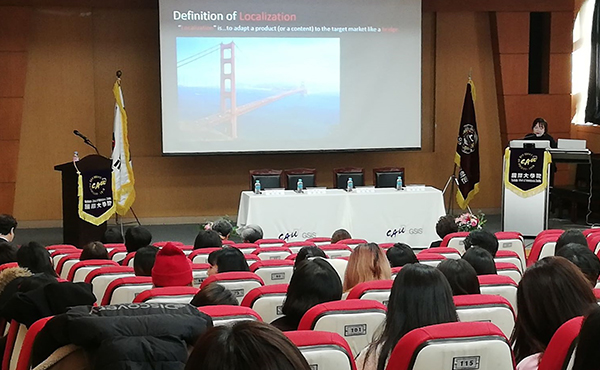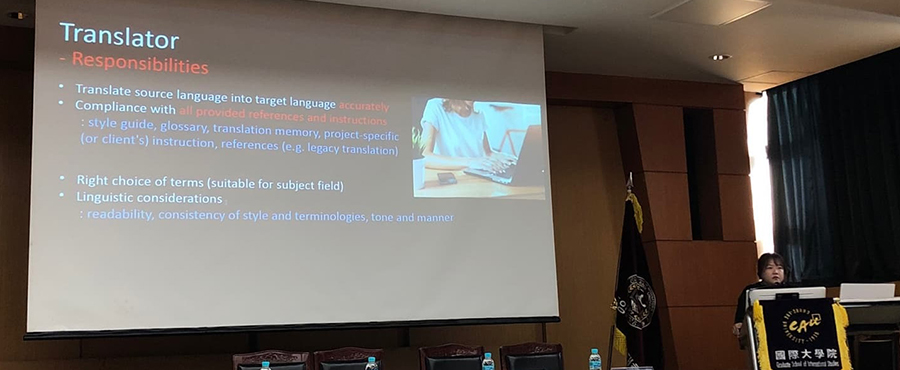

Hansem STORY


On November 22, we were invited by Chung-Ang University’s (CAU) Department of Interpretation to share our professional expertise with the professors and students of this prestigious university for the 15th anniversary of the founding of its Graduate School of Interpretation. As we considered what professors and students would find most interesting, we realized this conference would be a great opportunity for us to offer our professional perspective on the localization industry and shed some light on the various industry careers, other than translators and interpreters, and discuss how they contribute to each step of the localization process. Most people directly link translation to localization projects but tend to forget that translation only represents 40-50% of the process. Proper schedule management, translator support, and error response are some of the other factors that contribute to a successful translation project. For a localization business to be successful, it requires a wide variety of experts.

We were delighted to share our insights into the reality of the localization industry. And for this, what better spokesperson than Bolee Nam to address the audience? Bolee has been working as an active Senior Project Manager at HansemEUG for many years, so she knows all the ins and outs of the localization business.
Along with other professional speakers, she delivered an in-depth lecture about the complexity of translation projects and the professional opportunities offered by the language industry. Young graduates often worry about their first steps into the job market, mostly due to their lack of experience; but at the conference, they were shown that no matter what job they start with, they can build their own expertise and grow to be advanced translators and localization experts. Bolee did not hesitate to share her own personal experiences, as well as those of other HansemEUG employees, to show that the opportunities are endless as long as they keep an eye on the industry new trends, such as the advance of AI and MTPE or the emergence of new online CAT tools. Soon-to-be localization experts have to differentiate themselves by building a competitive edge, and we are hoping to push them in the right direction. It is always a great opportunity for us to give advice to those who may be our future colleagues and share our own experience in the localization scene.

So yes, there are a variety of careers available in the industry, but what are they and how do they complement one another? The lecture discussed how the localization process requires more than just translators to make a project go smoothly.
It all starts with the sales managers, who act as the link between the domestic and overseas customers and the company providing the service. They build trust with customers and are essential to providing customized consulting services. Once the customer’s needs are fully understood, the PMs take over. They are the main contact points that manage the project from beginning to end and are key elements to ensure that projects go smoothly. They communicate and work closely with everyone throughout the process while checking that all the requirements of the project are being met. PMs are the backbone of a project and act as a support group for both translators and clients. If there is a problem, PMs have the solution, along with the doc engineers who help with the pre and post-processing of project files with complex structures.
It is then time for the resource manager to intervene in order to secure the right resources to work with. That means finding and testing the right professional resources that match the project’s needs.
Translators, reviewers, language QA specialists, and DTP operators complete the work and deliver it to the customer by making sure they comply with all requirements and instructions. Quality feedback is regularly given to resources to help them keep on track with clients’ expectations and ensure high-quality output.
Through the challenges we have faced and our experience as an established LSP, we were able to share concrete examples of our daily work in order to explain the importance of functional teamwork to ensuring the stability of a project.

Every day, HansemEUG carries out translation projects in over 70 languages from around the world, and this cannot be accomplished through the efforts of just one person. It is a collaborative process where all members need to have solid knowledge of market trends, understand the latest technologies, and care about customers’ needs. Being a team player and thinking flexibly are the mainstays of a collaborative system. We are always happy to share our knowledge on the industry with future localization recruits and provide our input as professionals. We hope everyone who attended the conference learned something valuable they can use in the future.
Hansem Global is an ISO Certified and globally recognized language service provider. Since 1990, Hansem Global has been a leading language service company in Asia and helping the world’s top companies to excel in the global marketplace. Thanks to the local production centers in Asia along with a solid global language network, Hansem Global offers a full list of major languages in the world. Contact us for your language needs!
 Transforming B2C Sales Training with Gamification
04.14.2024
Transforming B2C Sales Training with Gamification
04.14.2024
 The Impact of Localization on Salesforce’s Success with Hansem Global
04.07.2024
The Impact of Localization on Salesforce’s Success with Hansem Global
04.07.2024
 Mastering Right-to-Left (RTL) Language Localization: Avoid the Top 5 Desktop Publishing (DTP) Mistakes for Global Success
04.03.2024
Mastering Right-to-Left (RTL) Language Localization: Avoid the Top 5 Desktop Publishing (DTP) Mistakes for Global Success
04.03.2024